How to recognize and treat Sweeney Shoulder in horses: ideas to manage your horse’s return to health. This blog is for everyone searching for information on the Internet and finding little to go on.

Table of contents
Lady’s story
How to recognize Sweeney Shoulder
Treatment
Acupuncture
Other ways to help
Lady’s improvement
Shopping list
The crime and resulting injury
On August 10, 2017, my horse Lady was chased by dogs. When my friend Melissa got home (I board at her place), she found Lady in the lower pasture. She had tied up and had wounds all over, particularly on the left foreleg. She was very lame, but it was difficult to see where the problem(s) was(were).
Using logical deduction (just about the only thing that would cause her to run around frantically was a pack of dogs, and the wounds looked like bites), I stated that, although we had not seen what happened, I was 95% certain it was dogs. Several days later we captured one of the culprits; a young puppy (at least) had returned to the scene of the crime and was too stupid to get through the fence when the kids came out.




To the vet
We called the vet and took her to the clinic. The apprentice vet suggested x-raying the left foreleg, but I was convinced it was superficial, and that belief was backed by senior vet who arrived later. The only relatively untouched lower leg was the right hind. She also had strange scrapes on her chest, and a swelling on her neck with punctures that could have been teeth. I thought she had run into a fence, but after walking the entire fence line, realized that was impossible.



Her blood work, unsurprisingly, was consistent with tying-up (duh, it was obvious). She stayed the night at the clinic and received a fortune’s worth of liquids. She also received Banamine, and the left fore was wrapped with DMSO and furacin (at an exorbitant cost, I should have done it before I left her).
Back home with questions
The next day I brought her home. The first few days, she didn’t know which leg to favor, she was so sore. She was confined to the stall for the most part, but I took her out to graze. By the third day I knew something was seriously wrong with her left fore. I had seen many horses tie up. This was not only exercise induced rhabdomyolysis. Unfortunately, I did not know how to recognize Sweeney Shoulder!
I did the best I could to take a video (ie I had my son do it) which I sent to my vet to convince him that yes, my horse was very broken, it was from the shoulder, and he needed to come out because I didn’t want to trailer her.
To help you recognize Sweeney Shoulder:
The above video was taken August 15. You can also see hives on her neck. For about a month, she would sporadically get hives on the left side of her neck, starting where the “bite” was. She became allergic to fly sprays (but I could use them as long as I didn’t get near the neck). No idea what that was about.
For those of you who would want to be able to identify Sweeney Shoulder, and find it difficult to see in the videos: the horse will pull the leg forward in a swinging motion, out from the elbow/shoulder. The toe may drag (Lady did this for about a month, 4-8 weeks post-injury). Once the foot is placed, the elbow will turn out as the horse steps forward with the sound leg. It’s unmistakable once you know what you’re looking for.
Of course, I did not know at the time.
I sent the video to my vet, Dr. Trent Bliss at Interstate Equine, the next day. He said give her bute (I’d already done that on my own initiative). Two days later I texted him and said she was worse, and couldn’t get up properly, so he came out the next Monday (August 21, 11 days after the injury).
Diagnosis (finally)
To be fair, I’d been regularly having the clinic look at Lady because of lamenesses I detected (and in one case, detected by two endurance ride vets –lameness pull) that were invisible or insignificant every time they looked at her. I have very sensitive unevenness radar.
The really good thing was that as soon as Dr. Bliss saw Lady walk on the 21st, he said “Sweeney.” (aka suprascapular neuropathy, or damage to the shoulder nerves).
I have since learned that many cases of sweeney are misdiagnosed because it is relatively rare nowadays. I had never seen a case outside of the veterinary encyclopedias I used to study to prepare for the written exam portions of Youth of the Year contests. My understanding (from my teenage days) was that it resulted from ill-fitting harnesses (collars); it was a disease of working horses (ironically, so was tying-up, or Monday morning disease, common in work horses that were given Sundays off on full rations).
Dr. Bliss also said, “wow, you’re right, it is the shoulder.” (The shoulder is often blamed for lower limb lameness, probably because from the saddle it feels like the shoulder isn’t working properly when the horse fails to fully extend the leg).
What is Sweeney?
Lady had an acute and severe case of sweeney. Taking into consideration the hematoma and bite marks on the lower left leg, we believe she was grabbed by a dog and fell, over-extending the left fore leg behind the rear legs (one cause of trauma-induced sweeney).
Sweeney Treatment
Lady was prescribed stall rest and EQUIOXX. a NSAID that can be administered long term to horses, for the foreseeable future. At least three months and probably twelve. At this time, she could barely get up, and couldn’t get up at all from the bad side (I had to roll her over when she fell). She fell several times in the week before the sweeney diagnosis, because she didn’t understand she was disabled.(Fortunately, she soon learned to balance.) It was very discouraging. Not only would I not be able to ride her, she wouldn’t even be able to carry a foal if she couldn’t get up.


Above are pictures from September 3rd, 3.5 weeks after injury. You can clearly see the atrophy.
What else could I do?
I asked advice on the AERC Facebook page, had my mom ask her vet clinic, asked friends… There seemed to be no established procedure and no guaranteed cure. Lady is insured, and they would have covered surgery, but I really did not want to do this (even though my vet did mention the option). The general consensus was that the best bet would be acupuncture–which of course the insurance did not cover.
Acupuncture
One month after the original trauma, I finally got an acupuncturist, Dr. Julia White, out. We did an initial video (below). Lady required sedation, and was still twitchy with flies, but Dr. White did electro-acupuncture and then left the needles in for another 20 minutes.
I had my doubts, and we still don’t know the extent to which the treatment aided recovery (no random assignment, etc), but one thing is certain: it must have felt good, because Lady loves her needle sessions. The second time Dr. White came, after one week, Lady recognized her as soon as she got out of the truck, and stood quietly for the needles. We’ve never had to sedate her again, even though she has turned into a bit of a fire-breathing dragon now she’s feeling better.
Other methods to treat Sweeney: TENS, balance trainers
Dr. White also advised using balance trainers (see picture below). Lady is also getting megadoses of Vitamin E and flax seed meal (for the omega acids). I use a TENS/EMS unit on her every day while cleaning stall, etc. (ideally one hour, but often less). At first I got no reaction from the atrophied muscle, but it has slowly improved. In the picture below, the TENS unit is in that blue bag, which I attached to Lady by slipping it under and old racing overgirth. (Link is to Amazon, and that one is probably fine, but I buy them from racing tack places–BigD Web has them too–for use in races!)
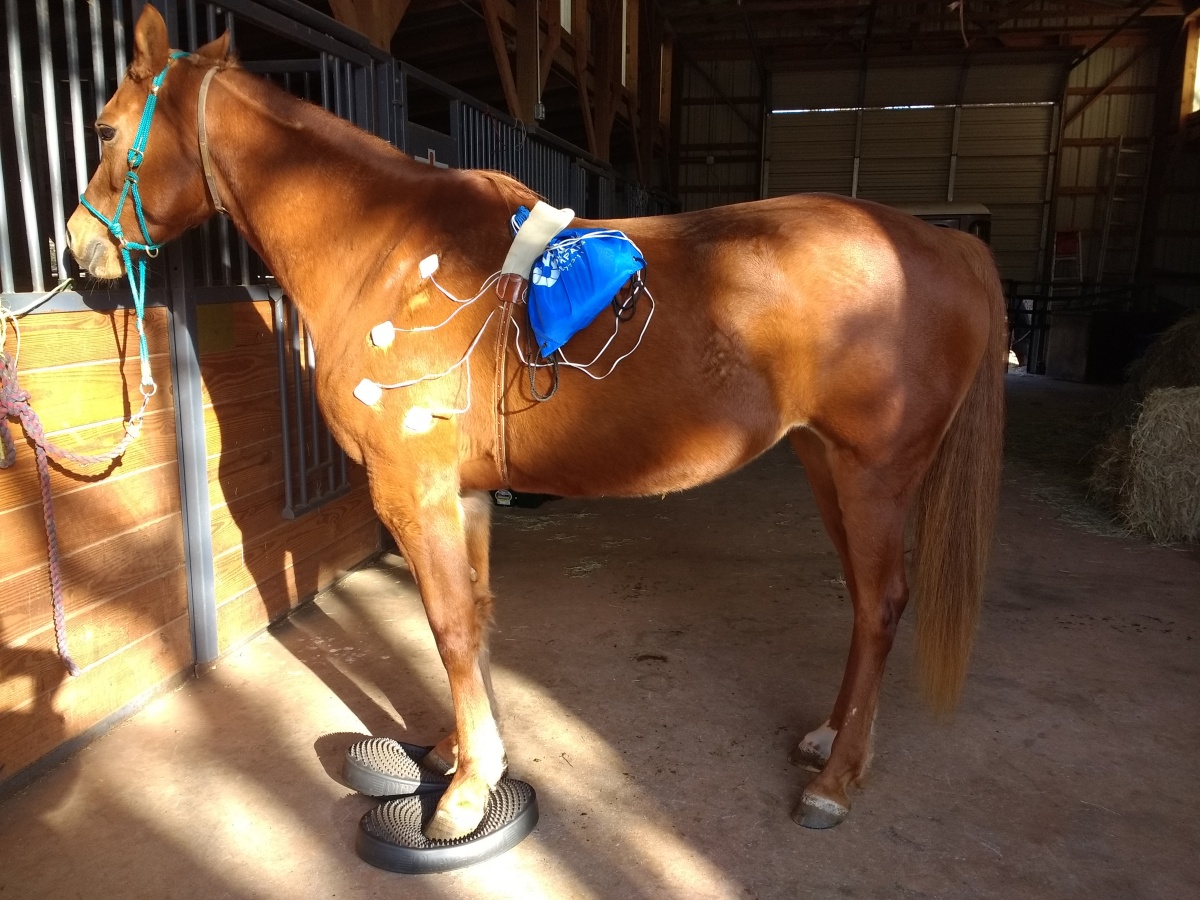
Exercise
I also took Lady out to roll in sand almost every day (sometimes in mud, if it had rained). She is on free choice grass hay (I fill four hay nets a day, and she has about half a net leftover in 24 hours), and one cup of Nutrena Safe Choice (split in two feedings). She gets about 1/3 cup Nutrena Pro-force fuel with her EQUIOXX and Vitamin E. I started hand walking in early October, with the goal of “not making her more lame” each time; ie I was supposed to stop before she got worse, which at the beginning was about one minute.
Electro-acupuncture session:





See all those needles in the above pictures (Taken November 1st)? Lady doesn’t move a muscle during application. Her last session was yesterday. She also got a chiropractic adjustment; rearing and levitating is not good for you when you are already damaged. Next treatment will be in January.
Getting better!
The reason I am finally completing this blog is that I am hopeful, at last, after nearly four months, that I might be able to not only breed Lady, but potentially ride her as well. On Monday, Lady went nuts after her roll. Rearing, jumping, scootching around like an 850 lb greyhound in back of me. So I left her in the round pen to get a longe rope (she ground ties just fine even when she won’t lead). I sent her around me in both directions, bucking and snorting for about 30 seconds, to get her manageable. Then I took the video below.
She’s a different horse! Even after already having played more than she had in four months, she was barely lame, and had only a tiny bit of sweeney in the elbow at the walk. I was very excited and shared the video with Dr. Bliss. Dr. White came out yesterday and agreed with me that she was doing fantastic, considering the severity of the injury and the short time that has passed. Of course, she was much more lame on Tuesday, but already improving again yesterday. Still sore today, but not too bad. Dr. Bliss says I’ll know she’s mostly recovered when she does the crazy two days in a row.
Safety first
Of course, now comes the difficult part: keeping her from damaging the rest of her body while she recovers, and/or redamaging the nerve by being stupid. She has to stay in the stall, on EQUIOXX, and have controlled exercise (i.e., hand-walking), until she’s in no danger of injuring herself. I am fantasizing with occasional turnout on good (not slippery or muddy) terrain, with horses near but not in with her, at around six months. I cannot wait to get her out of the stall permanently though, so I don’t want to rush things.
Video of today’s therapy session:
I will add to this in a few months, to document the changes.
Update July 2018
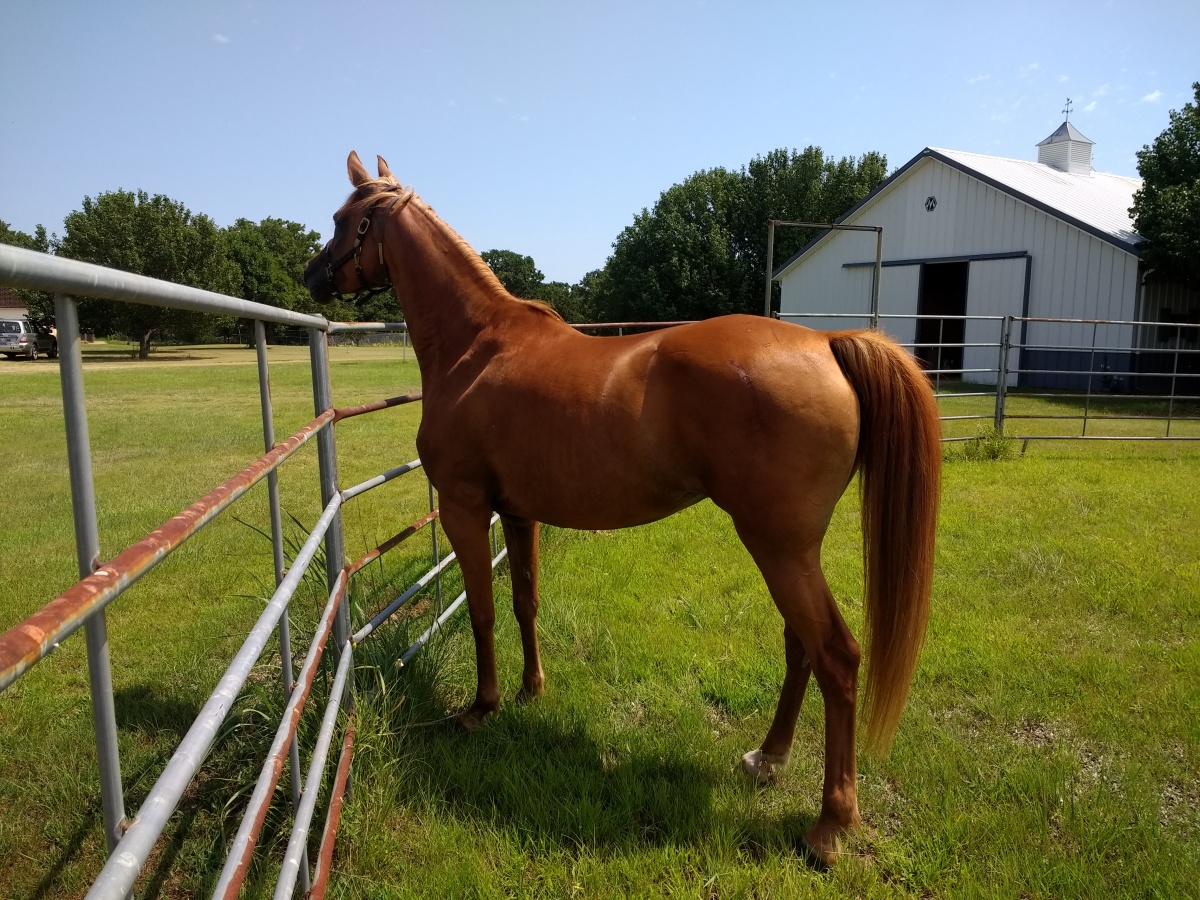
Lady has been in a pasture since March She is fairly quiet and primarily walks. My vet (Dr. White) told me at the end of May, after Lady’s last acupuncture session, that I could start working her if I wished, but I haven’t… she trotted out well that day, in hand in a straight line, but that left shoulder is still very atrophied. Yesterday (July 21) I worked her briefly in the round pen. She trots soundly to the left, but is a little bit lame to the right, and bends out. She may –in fact, undoubtedly would– need regular adjustment if I were to use her. At the moment, she’ll stay in the pasture, and hopefully I’ll be able to breed her next year, finances permitting. At some point I may try to bring her back into use, but not now.
Below are the two videos I took yesterday.
To the left, apparently sound (the blood is from fly bites)
To the right, lame on right (secondary issue; she’s crooked):
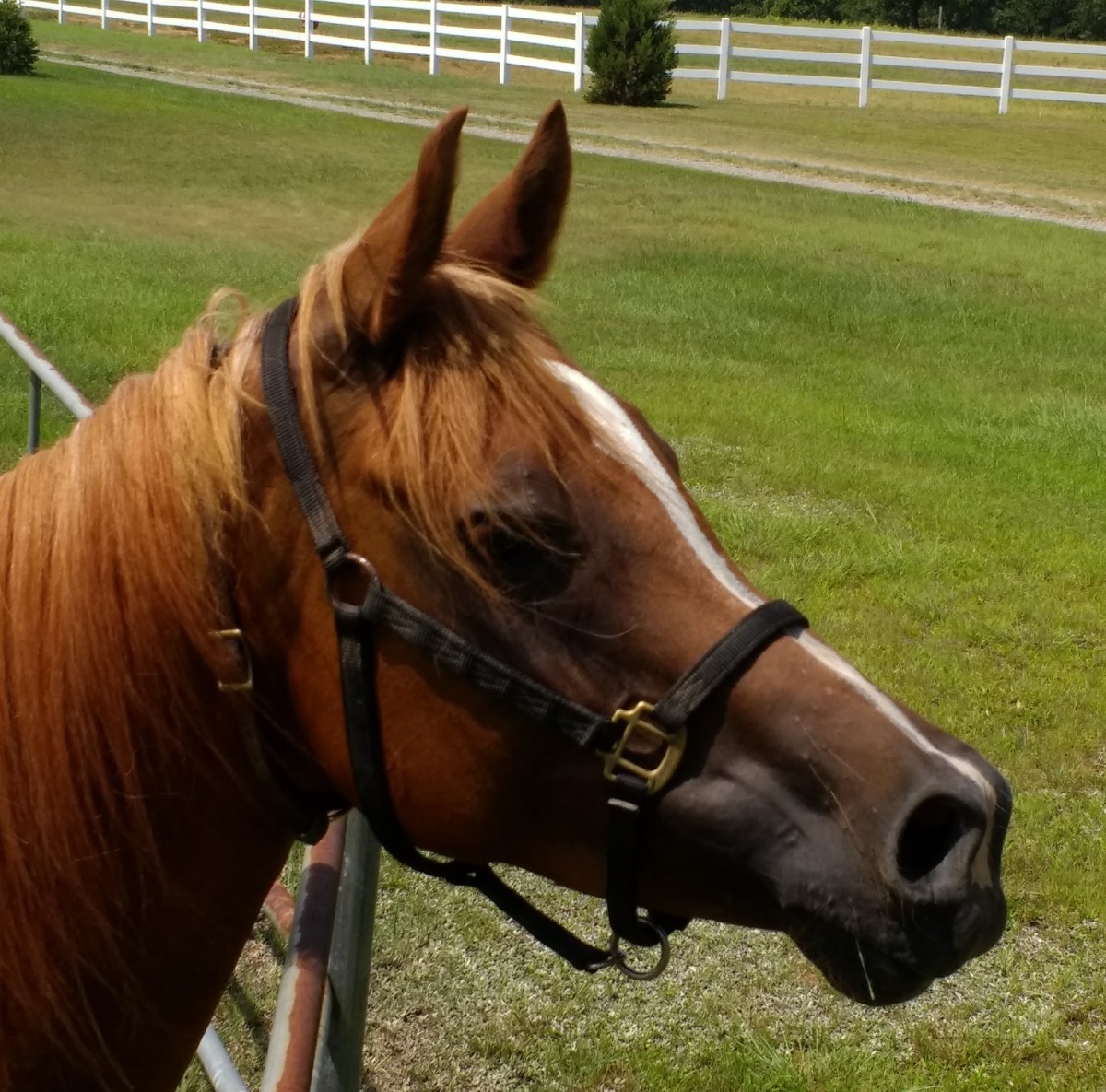
Update 16 August 2018
One year and six days post-injury, Lady was not as lame in the round pen as she was about 3 weeks ago (the ground was softer and she was excited), but she was still sore. She had been trimmed Sunday, and her heels were sore (to testers); Lady has always been high-low, with her low foot (right) very thin-soled. She was also still crooked, and sensitive on both sides (shoulder).
I could begin riding/working if I wanted. It would take time, much attention to balance, and regular chiropractic adjustments and acupuncture. I don’t have the money or time right now, and I’ve got another horse to entertain me, so Lady will continue her pasture life in a nice horse resort.
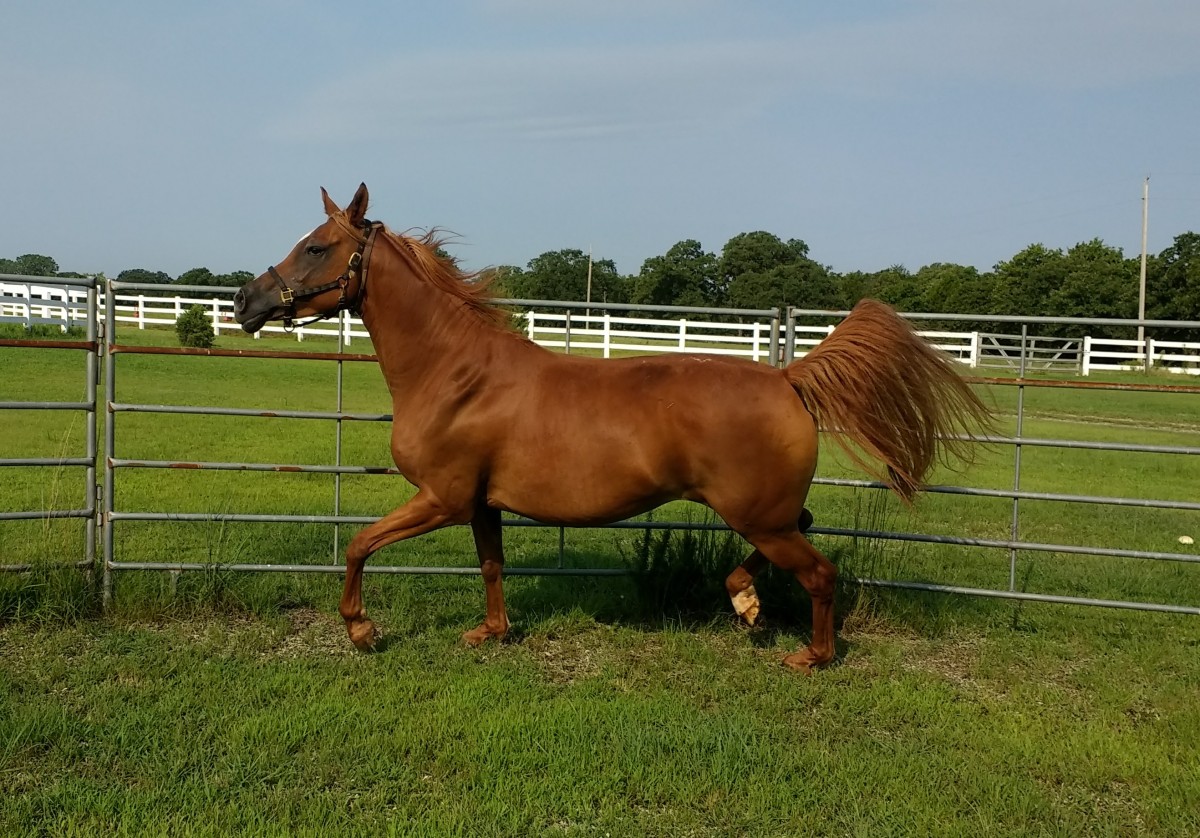
Update 3 September, 2018:
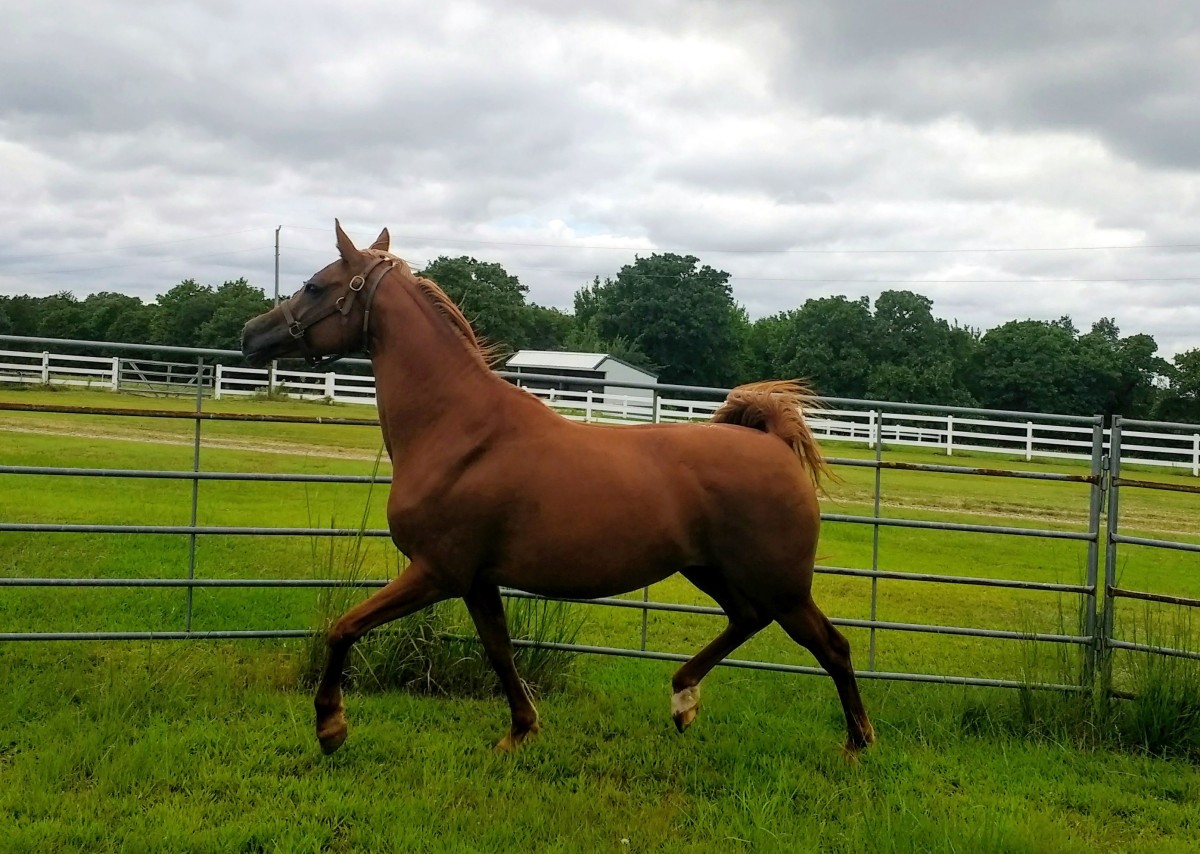
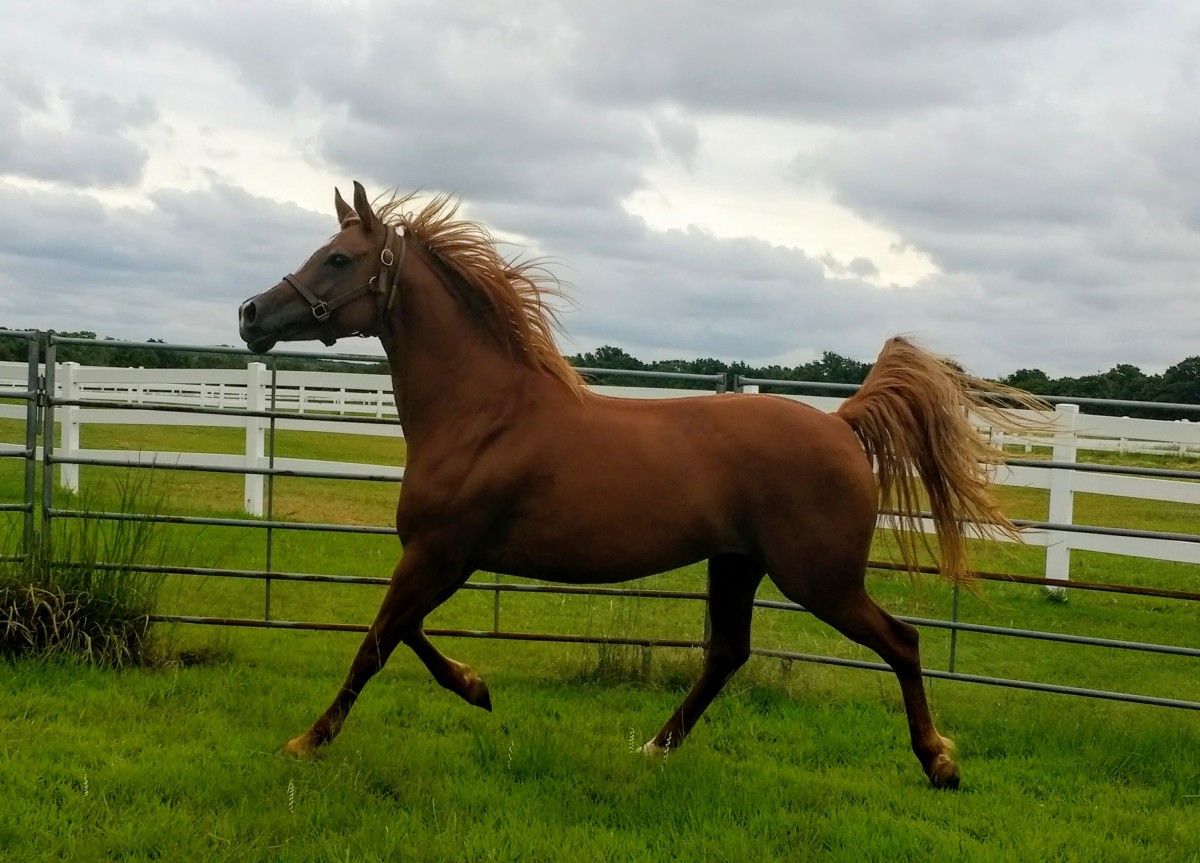
2 February 2019: She gallops around the pasture, and is eager to be worked. I put a saddle on today (after lots of trotting, so she wouldn’t buck).
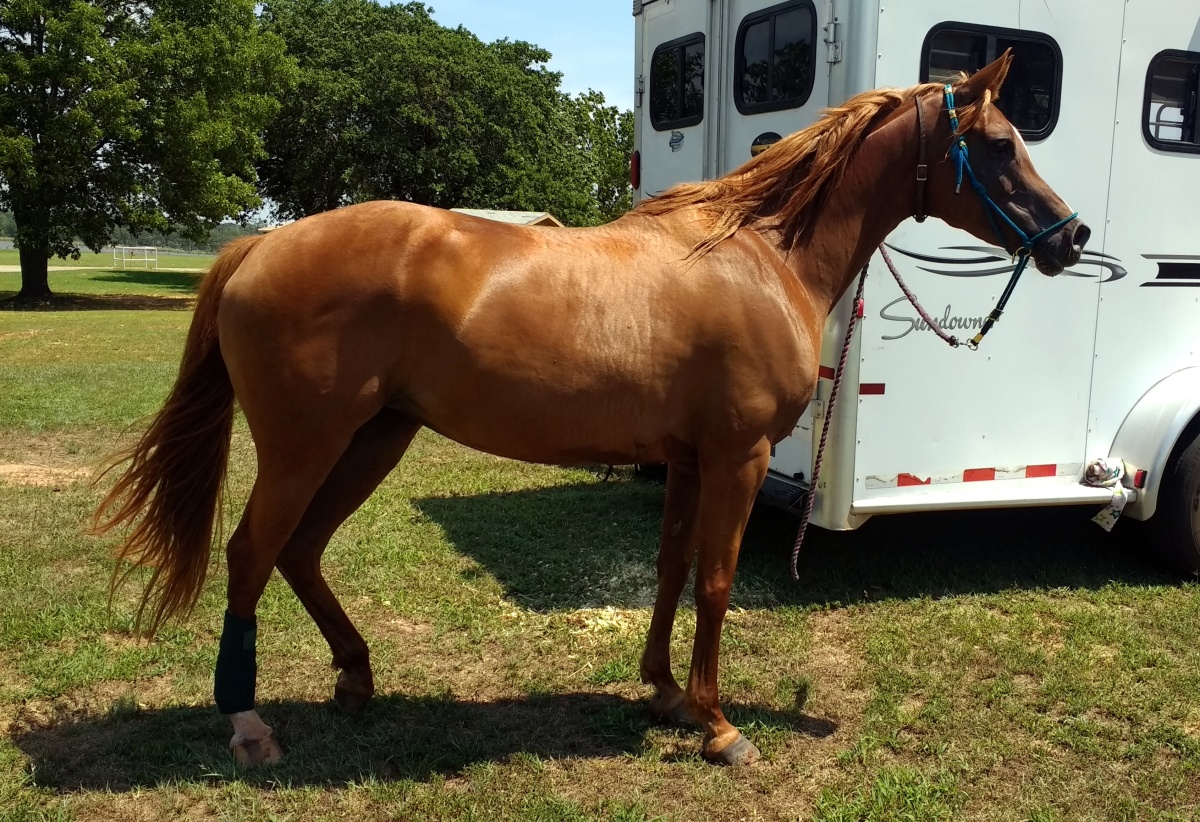
Shopping list:
Some things that can be useful to treat Sweeney shoulder:
TENS Unit
You will need extra electrodes and gel. Amazon no longer sells the electrodes I bought, but this gel is great. Gel is very important, as it conducts electricity. The longer the horse’s hair, the more gel you need (I actually clipped her hair short in the winter).
Theraband Balance & Stability Trainer
See my list that includes good general horse shopping sites

Great news that she’s recovering so well !!! Dawn
https://soulhorseride.wordpress.com/2014/08/12/one-third-two-thirds-the-good-and-the-bad/
https://journalofdawn.wordpress.com/2017/11/08/overcoming-injury-life-lessons/
Pingback: Racing vs riding and the US Endurance debate | jessica e black
Thank you for this interesting blog. My horse stepped in s hole about 8 months ago so I am dealing with similar issues. Can you please post where you bought the balance trainers and also a bit more info about the tens units you utilized? Thank you and best wishes.
Will add links tomorrow!
I’ve added links to the TENS unit and balance trainers I bought. I also bought extra pads etc., adding those links now…
Pingback: Changes – Wild Horses
Pingback: Review: Zaldi Endurance saddle Endur-Light : Wild Horses
Pingback: Some notes on scratches : Wild Horses Horse care
Pingback: On the stress of being a vet(erinarian). : Wild Horses : Opinion
Pingback: The Road to the Tevis Cup, Post #1: Introducing Fantazia
Pingback: Road to the Tevis Cup Post #20: Finding the right saddle - Wild Horses
Pingback: Saying good-bye to Beroni (Road to the Tevis Cup, Post # 45)
Your vets provided emergency care to save your horse’s life. Sometimes you find surprises on x rays (eg, gas in a joint space or embedded foreign material) so offering them wasn’t wrong. You even have insurance. Why complain about the cost?? Seems pretty petty to complain about the cost of a bandage or fluids. They have to charge for time, materials, and overhead, plus extensive training. Please consider the effect complaints like this have on the veterinarian profession before every last equine vet has burnt out and quit.
Sorry it took a while to reply, I had to go back to my post to figure out what you were talking about. I didn’t complain about the cost (though of course cost is always a consideration)… I just didn’t believe xrays to be necessary. The senior vet, when he arrived, agreed with me. Had he told me xrays were needed, I would have let them do them.
I highly doubt that me having my own opinion is going to damage any vet 😉
See my post about the stress of being a vet!
https://jessicaeblack.org/stress-of-being-a-vet/
Pingback: Everything I am doing wrong (Road to the Tevis Cup, Post # 46)
Pingback: The advantages of ground-tying: Road to the Tevis Cup # 52
Pingback: Why I don't give horses "time to settle in" - Wild Horses
I really enjoyed your story . My large pony got kicked April 4,2022. Found her in pasture reluctant to move around 3pm that Monday . Called manager to come out to help chase the herd away while she and I came in. Emergency call later , not broken but nerve damage. A few days later noticed back left leg not right . Vet somehow overlooked it during emergency call. Diagnosis was left shoulder injury and medial patellar ligament tear with avulsion fracture. My pony was diagnosed with mild navicular in 2017 and was doing very well until this accident. We are 31 wks later and started in saddle work in October. We did lots of walking therapy and pemf , jogging next to her in 5 min lines and then 10 min lines all of September. It was exhausting. We still have some mild atrophy 7 mos later but vet says hind end healed fine. Up to 1hr walking and 5 min trotting. She’s still off and block didn’t help hoof significantly so vet said more time and reevaluate in spring. Been doing trails and light ring work . I read your article in the beginning and you gave me hope! Wish I could share pictures of her shoulder . Ty for your help !
Pingback: Road to the Tevis Cup Post #29: The 300-mile rider requirement
Pingback: Meet my new mare River (Road to Tevis #102)